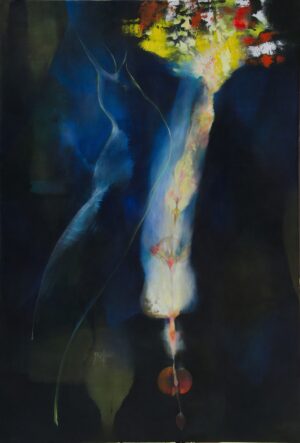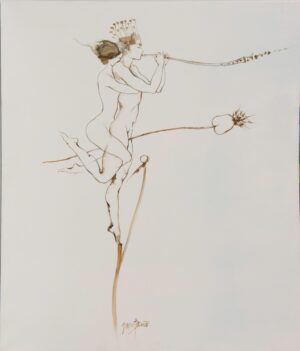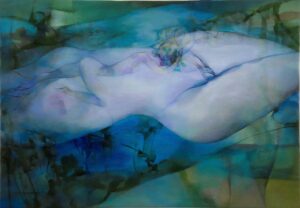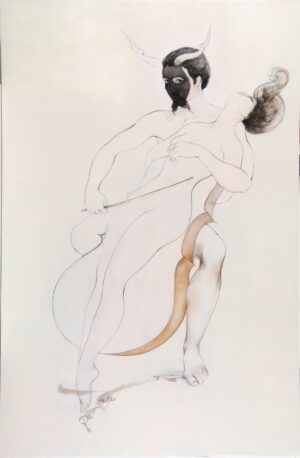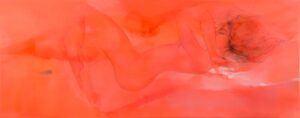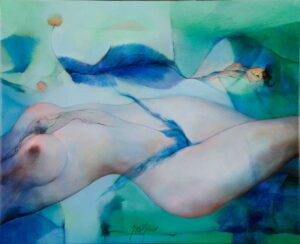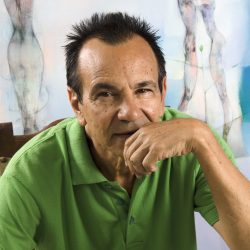
Ernesto García Peña – The Poetry of Dreams
Related Events
About Artist
Ernesto García Peña - The Poetry of Dreams
By: Dolores Denaro, Art Historian and Curator - Text based on Catalog of Exhibition
Ernesto García Peña (*1949, Matanzas, Cuba) belongs to the first post-revolutionary generation of Cuban artists and in Cuba is recognized as one of the best known and respected artists of his country as is reflected his the long list of his exhibitions.
Upon completing his studies at the Academy in Havana, he remained as a professor and for many years influenced the generations that followed.
The motifs of his paintings – as evidenced by the title of the exhibition and of the present catalogue – resemble lyrical poetry. Each oeuvre is a poem marked by the lyricism and the visual language of dreams. Imagination and intuition are always at its core. Visually, the works are marked by an aesthetic of delicacy and oscillate between the surreal and the abstract. García Peña uses acrylic paint like watercolors and by aqueous application of the acrylic on the surface with paint brushes and flat brushes obtains a transparency that is full of light .
The different elements are presented on the canvas as a breeze or distant memory. The paintings nourish from this delicate and yet radiant coloring - mainly in shades of blue, gray or red - from the empty spaces that reveal the beige background, as well as from the overlap of the layers that are often complemented with drawings from above or below. García Peña is “…an artist of atmospheres of subtle transparencies…“, which are the result of a long road of searches and explorations“.1
Search for Beauty and Harmony
The artist focuses on transmitting his emotions and fantasies around hedonistic topics. At the core is the ethical principle of the search of sensual pleasure and enjoyment. His work is an obsessive search of beauty and harmony, however he discloses very little about the content of his creations. He leaves the interpretation of his motifs to the viewers. The titles of the paintings provide a clue towards a possible reading of the artists intent and towards the paintings reading, since García Peñanames his work after completion, led by his own associations with his work.
Cuando todo comienza (span. When Everything Begins, page 15 shows two hills that represent the oversized breasts of a woman. On one of them lies a naked masculine figure in profile, with eyes closed. He seems to be crawling towards the nipple on his thorax, devotedly inhaling the oncoming fragrance. The stylized igniting spark emerging from one of the nipples recalls the first hours of human life, when the female breast develops from a sensual feminine organ into the first source of nourishment for every human being.
In general, the enigmatic feminine nude is omnipresent in all of García Peña’s works. In El ritual de… (span. The Ritual of ..., page 33 the sensual body of a naked woman seems to be floating between the sky, the water, and the landscape. Only upon second look it becomes apparent that there is another, smaller sized erotic female figure in opposite direction within the first. In Amaneceres (span. Daybreaks, page 32) with a similar motif, an androgynous figure lies in ecstasy between the breasts, while above float two other bodies, unified.
Idyllic Scenes
Overlapping bodies of different dimensions are a typical feature of García Peña’s works. Similarly, erotic scenes are in all his creations - some with stylized feminine nudes and others with couples floating freely on the image surface. The fragility of love is expressed in accordance with the subtly indulgent application of color. Images of “beautiful” dreams are also always idylls, i.e., harmoniously clarified motifs that influence the spectator in a nice and peaceful way. The idylls, in turn, are illusions threatened at the same time by disillusion.
The bull and - more often - the horse, serve the artist as allegory of passion, movement, and virility. While in European iconography the symbolism of the horse depends essentially from its color – white meaning bearer of light and black, death and ruin – the Cuban artist is much more interested in the strength and energy that are inherent to this animal. In Montate y (span. Mount and…, page 19) a naked woman is levitating with her arms extended backwards within a huge horse head. She is sitting on the shoulders of an equally naked man, who holds her around her legs. She obviously enjoys the state of unrestrained freedom, as if she was sitting on the bow of a vessel gliding over the sea with windswept hair. On the nape of the horse another couple lies, one person on top of the other, while from the torso an androgynous figure with wings rises toward them.
El último canto de la bestia (span. The Last Song of the Beast, page 23) shows a stylized feminine figure within the body of a bull, playing the violin. If one understands the bull as masculine, one might be tempted to recall the story of creation in the Holy Scriptures, in which Eve - depending of the translation - was created from a bone (a rib) of Adam.
Island Lyrics
Generally, Ernesto García Peña works in parallel on several paintings, so that the temporal and visual distance with a painting motif may mature in the artist’s conception. Usually, when he stands before the blank canvas, he already has concrete concepts of what he is going to paint. Later he lets himself be carried away in the process by his intuitions. He attempts not to follow predefined processes or procedures in order not to bind or restrict himself. However, he occasionally uses ideas he had before, or resorts to one he had already drawn or sketched at an earlier occasion. The time he takes to complete a painting - which he frequently produces aspart of a series, varies according to its development,. And analogous to poetry - short rhymes or longer poems arise, all created in the Caribbean island.
---
1 According to Cuban art critic Virginia Alberdi. See text on the invitation card to the exhibition of García Peña in ArteMorfosis Gallery.
2 See encyclopedia of the iconography: dev.beyars.com/kunstlexikon/lexikon_8834.html
Curriculum
Ernesto García Peña. 6 de marzo de 1949, Matanzas, Cuba.
Graduado Escuela para Instructores de Arte (1965); Escuela Nacional de Arte (1970);
Licenciado de Artes Plásticas, Instituto Superior de Arte (1987)
Profesor de Dibujo en la Academia de San Alejandro (1969-1970)
Profesor de dibujo, grabado y pintura en la Escuela Nacional de Arte (1970-1989)
Asesor para Programas de estudios de dibujo de 1973-1989
Asesor nacional de la Secretaria de Artes Plasticas, Luanda, Angola (1978-1979)
Miembro del Taller Experimental de Grafica de La Habana desde 1973.
Miembro de La UNEAC y de la Asociación Internacional de Artistas Plásticos, UNESCO.
Ha participado en numerosos intercambios culturales en diferentes países.
Poseen obras suyas el Museo Nacional de Bellas Artes, Cuba, Museo de Arte Memorial América Latina, Brasilia, Brasil; Museo de Arte Moderno Miskolc, Hungría, Museo de Arte Las Ameritas Managua, Nicaragua. -Biblioteca Nacional Jose Marti, Cuba.Ministerio de Cultura, Cuba.Consejo Nacional de las Artes Plasticas, Cuba.Oficina del Historiador de la Habana, Cuba. Centro de Estudios Martianos, Cuba.

